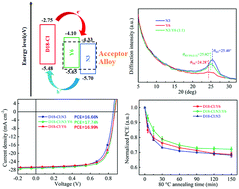Non-fullerene acceptor alloy strategy enabling stable ternary polymer solar cells with efficiency of 17.74%†
Abstract
For optimizing the performance of photovoltaic devices, fabricating ternary organic solar cells (TOSCs) is a common strategy. However, the hybrid system involves complex intermolecular interactions, which poses a challenge to the choice of the third component. Herein, we report a TOSC based on D18-Cl : N3, combined with a high-efficiency small molecule non-fullerene Y6, which has similar chemical structures to the host acceptor, to form an acceptor alloy. By forming an alloy state in the blend film, the performance of the device is enhanced and the stability of the device is improved. After optimizing the mass ratio of the third component, it was found that the performance was best when 50 wt% Y6 was added. After balancing the carrier mobility, reducing energy loss, and improving the film morphology, the best power conversion efficiency (PCE) of 17.74% is obtained. In addition, The alloy state of the two non-fullerene acceptors N3 and Y6 also effectively improves the heat resistance and light radiation stability of the device. Our results prove that choosing non-fullerene acceptors with similar chemical structures and electrical properties to form an alloyed acceptor is a reasonable and reliable ternary strategy that can further improve the performance of organic solar cells.



 Please wait while we load your content...
Please wait while we load your content...